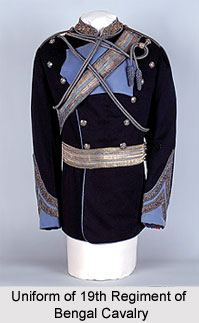 The 19th Regiment of Bengal Cavalry was a military regiment of the British Indian Army which existed from the year 1861 to 1922. The army unit was a part of the Bengal Army, which was the armed forces of Bengal Presidency and was amongst the 3 main Presidency Armies in British India. The British Presidency Armies belonged to the British East India Company until the Great Revolt of 1857. The Government of India Act 1858, which was authorized after the Sepoy Mutiny in the year 1857, transferred the authority of the 3 Presidency Armies to the British Empire in India. In the year 1903, the 3 separate presidency armies were united to form the combined British Indian Army. The 19th Regiment of Bengal Cavalry was also known as the 19th Regiment of Bengal Lancers and the 19th Lancers (Fane`s Horse) regiment.
The 19th Regiment of Bengal Cavalry was a military regiment of the British Indian Army which existed from the year 1861 to 1922. The army unit was a part of the Bengal Army, which was the armed forces of Bengal Presidency and was amongst the 3 main Presidency Armies in British India. The British Presidency Armies belonged to the British East India Company until the Great Revolt of 1857. The Government of India Act 1858, which was authorized after the Sepoy Mutiny in the year 1857, transferred the authority of the 3 Presidency Armies to the British Empire in India. In the year 1903, the 3 separate presidency armies were united to form the combined British Indian Army. The 19th Regiment of Bengal Cavalry was also known as the 19th Regiment of Bengal Lancers and the 19th Lancers (Fane`s Horse) regiment.
History of 19th Regiment of Bengal Cavalry
The 19th Regiment of Bengal Cavalry was developed by Captain Walter Fane as the regiment of Fane`s Horse at Cawnpore (Kanpur in Uttar Pradesh) in the year 1860. It was raised with the purpose of providing armed service in the Second Opium War. The battalion participated in various operations in China, namely at Pale Chiao, Chanchi Wan and Sinho. Later, the 19th Lancers (Fane`s Horse) regiment participated in the capture of the Chinese capital of Pekin, also known as Beijing.
In the year 1861, the military regiment was renamed as the 19th Regiment of Bengal Cavalry. It was again re-designated in 1864 as the 19th Lancers. The army unit provided service during the Second Afghan War and also took part in the Battle of Ahmad Khel in the year 1880. During the First World War, the 19th Regiment of Bengal Lancers was stationed with the Indian Cavalry Corps in France. It participated in the Battles of the Somme and Cambrai. Later in 1918, the British Indian Army regiment participated in General Allenby`s campaign in Palestine and also fought valiantly in the Battle of Megiddo.
After the conclusion of the First World War, the British Indian army decided to reduce the number of cavalry regiments by uniting various military regiments together in pairs, instead of dissolving the surplus regiments. As a result the whole cavalry line was re-designated and renumbered. The 19th Regiment of Bengal Cavalry was merged with the 18th Regiment of Bengal Cavalry (18th King George`s Own Lancers) in order to raise the 18th/19th Cavalry in 1922. This regiment was renamed as the 19th King George`s Own Lancers in the year 1923 and later in 1937, as 19th King George V`s Own Lancers.
Designations of 19th Regiment of Bengal Cavalry
The regiment of 19th Regiment of Bengal Cavalry of the British Indian Army had several designations through out its existence. These are mentioned below-
* 19th Regiment of Bengal Cavalry - 1861
* 19th Regiment of Bengal Cavalry (Lancers) - 1864
* 19th Regiment of Bengal Lancers - 1874
* 19th Bengal Lancers - 1901
* 19th Lancers (Fane`s Horse) - 1903



















